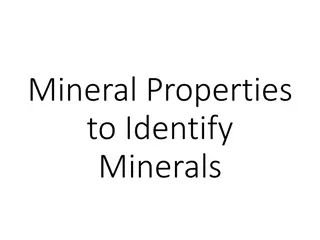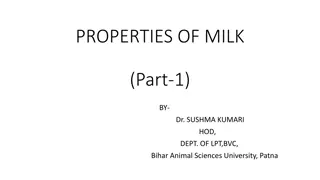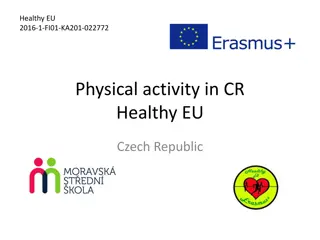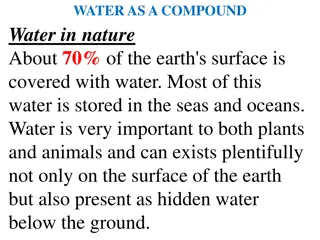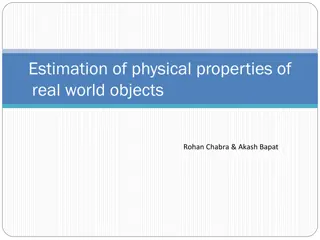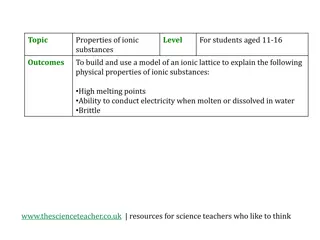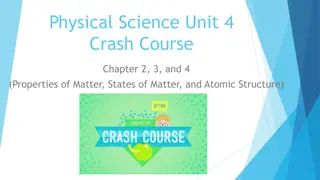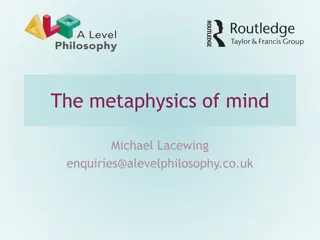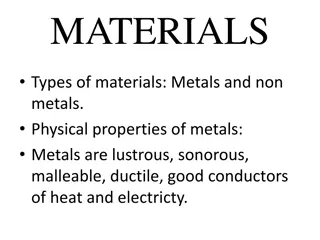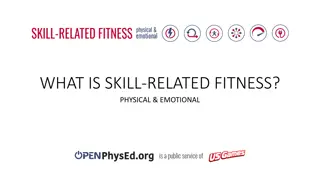Physical Distribution
Physical distribution is a critical aspect of business operations involving the planning, implementation, and control of the flow of goods from origin to consumer. Philip Kotler and William J. Stanton have defined physical distribution as a process of managing the movement of goods to meet consumer
0 views • 8 slides
Exploring the Meaning and Definitions of Physical Education
Physical education involves systematic training and instruction related to physical activities for the development and maintenance of the human body. It encompasses the growth of physical power, the cultivation of physical skills, and overall enhancement of physical well-being. Various definitions h
8 views • 7 slides
Importance of Fitness Testing in Physical Education
Health-related physical activity (HRPA) stresses the need to view fitness testing as a tool to promote increased physical activity levels rather than an end goal. The focus in school physical education is on equipping youth with the knowledge and skills for lifelong health. Fitness test protocols sh
0 views • 17 slides
Understanding the Rule of Mixtures in Composite Materials
The Rule of Mixtures (ROM) is a weighted method for predicting the properties of composite materials, such as fiber-reinforced polymers (FRP). This method relies on assumptions regarding the homogeneity and properties of fibers and matrices. By combining volume fraction and properties linearly, the
5 views • 23 slides
Understanding Saponin Glycosides in Pharmacognosy: Properties and Applications
Saponin glycosides, found in various plants, are compounds with diverse benefits ranging from cholesterol regulation to potential anticancer properties. They form colloidal solutions in water and are used in soap manufacturing due to their unique properties. Additionally, saponins have bitter taste,
6 views • 18 slides
Understanding Properties and States of Matter in Physical Science
Matter is made up of elements that cannot be broken down further. Different mixtures have distinct properties, such as solutions, colloids, and suspensions. Physical properties like viscosity and density can be observed without changing the material's composition. Chemical properties, like flammabil
2 views • 15 slides
South East Asia Collagen
Collagen, with its unique properties, has been extensively used in food processing industries. These properties are usually categorized into two groups. First, the properties associated with its gelling behavior, such as texturizing, thickening, gel formation, and water binding capacity, and second,
0 views • 2 slides
Understanding Pharmaceutical Degradation: Types and Factors
Pharmaceutical degradation refers to the process of a formulation in a specific container losing its chemical, microbiological, therapeutic, physical, and toxicological specifications. It can be categorized into physical, chemical, and microbiological degradation. Physical degradation alters the dru
1 views • 50 slides
Guidelines for Handling Case Properties and Seized Assets in Legal Proceedings
This informative content discusses the handling of case properties involved in offenses, including seizure, custody, disposal, and coordination among government departments. It covers various aspects such as the types of case properties, custody procedures, provisions under Section 516-A Cr.PC, and
0 views • 8 slides
Understanding Furan and Thiophene: Structures, Properties, and Uses
Furan and Thiophene are important heterocyclic organic compounds with distinct structures and properties. Furan, a five-membered aromatic ring, is used in specialty chemical production and has unique physical properties. Thiophene, a sulfur-containing compound, finds applications in agrochemicals an
2 views • 8 slides
Classification of Elements and Periodicity in Properties: Overview and Evolution
The journey of understanding the classification of elements and periodicity in properties begins with early laws like the Law of Triads and Newland's Law of Octaves. Mendeleev's Periodic Law revolutionized the organization of elements, leading to the modern periodic table. Discoveries of eka-alumini
3 views • 32 slides
Understanding Physicochemical Properties of Drugs
The physicochemical properties of drugs play a crucial role in their pharmacological effects. These properties include physical and chemical characteristics that influence interactions with biomolecules. Solubility, partition coefficient, and dissociation constant are key factors affecting drug beha
1 views • 46 slides
Algebra Rules and Properties
Explore the fundamental rules and properties of algebra and indices, including commutative, associative, and distributive properties. Learn about negation, zero properties, and the zero factor property, illustrated with examples and common errors. Engage in activities to apply and test your understa
1 views • 21 slides
Understanding Wikidata Properties and Data Types
Learn about Wikidata properties and data types, their importance in structuring data, and how they are used to create statements and qualifiers in Wikidata. Explore the purpose of properties, their labels, descriptions, aliases, and data types such as items, strings, monolingual text, external ident
0 views • 26 slides
Understanding Physical and Chemical Properties of Matter
Explore the distinction between physical and chemical properties of matter in Chapter 2, Section 2. Physical properties can be observed without changing the substance's identity, such as color and density, while chemical properties require altering the substance to observe characteristics like react
5 views • 20 slides
Understanding Physical Properties for Mineral Identification
Explore the key physical properties used to identify minerals, including color, streak, hardness, cleavage, fracture, luster, and density. Learn how these properties play a crucial role in mineral identification and how to apply them effectively.
0 views • 26 slides
Understanding Nonelectrolytes in Solutions
Physical properties of substances are classified into colligative, additive, and constitutive properties. Colligative properties depend on the number of particles in a solution and are similar for different nonelectrolytes. Additive properties are based on the total contribution of atoms, while cons
1 views • 14 slides
Understanding the Physico-Chemical Properties of Milk - Part 1 by Dr. Sushma Kumari
Physical and chemical properties of milk including its physical state, acidity levels, pH, density, freezing point, color, and flavor are discussed in detail in this informative article by Dr. Sushma Kumari from Bihar Animal Sciences University. Key points covered include the nature of milk constitu
0 views • 7 slides
Research Work for Physical Activity Statistics in the Czech Republic
The Czech Republic excels in measures of well-being but faces challenges in income and wealth distribution. Research in physical activity statistics focuses on various aspects like strength, speed, mobility, and mental well-being. Initiatives include assessing energy expenditure from basic activitie
1 views • 23 slides
Understanding Density and Physical Properties of Matter
Matter possesses physical properties that can be observed without changing its identity, including color, shape, length, mass, volume, and density. Density is the amount of mass per unit volume, where D = m/V. Objects with the same volume but different masses can have varying densities. Density can
1 views • 7 slides
Water as a Compound: Essential Properties and Properties
Water, a vital element covering 70% of the Earth, is composed of hydrogen and oxygen. It has various physical and chemical properties, acts as a universal solvent, and plays crucial roles in nature. From boiling and freezing points to chemical reactions, water's significance is undeniable. Its sourc
0 views • 63 slides
Estimation of Physical Properties in 3D Scene Understanding
Understanding physical properties of real-world objects through estimation techniques is crucial for developing intelligent systems that can predict collisions, track objects, and simulate interactions. This involves utilizing computer vision, data acquisition tools like Microsoft Kinect, and advanc
0 views • 25 slides
D-Block Elements: Properties and Classification in Chemistry
Welcome to the Department of Chemistry at Kisan Veer Mahavidyalaya, Wai. Explore the Chemistry of Elements of the 3d series, focusing on d-Block Elements and Transition Elements. Learn about their electronic structure, colored ions, magnetic properties, oxidation states, and complex formation. Under
0 views • 34 slides
Understanding Physical and Chemical Properties of Matter
Explore the distinction between physical and chemical properties of matter in Chapter 15, Section 2. Learn to classify properties such as color, flammability, odor, shape, taste, density, and more. Understand how physical properties can be observed without altering the substance's identity, while ch
0 views • 17 slides
Understanding Physical Fitness and its Components
Physical fitness encompasses health-related and skill-related components that contribute to overall well-being. Health-related fitness includes muscular strength, endurance, cardiorespiratory endurance, flexibility, and body composition. On the other hand, skill-related fitness comprises speed, agil
0 views • 22 slides
Reimagining Physical Education: A Holistic Approach at St. Peter's Girls Prep School
In the context of St. Peter's Girls Prep School, the philosophy around physical education is explored, emphasizing the integral role it plays in a child's holistic development beyond just playing sports. The approach focuses on instilling healthy habits, balanced nutrition, and physical fitness alon
0 views • 18 slides
Understanding Medical Records: History, Physical Examination, and Abbreviations
Medical records play a crucial role in documenting a patient's medical history and findings from physical examinations. The history and physical (H&P) document includes subjective information from the patient and objective observations by the examiner. The history (Hx) record covers personal medical
0 views • 20 slides
Exploring Physical Properties of Ionic Substances through Model Building
Engage students aged 11-16 in an interactive activity to understand the physical properties of ionic substances such as high melting points, ability to conduct electricity, and brittleness. By building a model of an ionic lattice for sodium chloride and explaining how the structure relates to these
0 views • 5 slides
Exploring Properties and States of Matter in Physical Science
Matter, comprising elements and compounds, exhibits various physical and chemical properties. Mixtures can be solutions, suspensions, or colloids, each with distinct characteristics. Physical changes maintain substance composition, while chemical changes alter it. States of matter include solid, liq
0 views • 15 slides
Understanding Transitivity of Properties in Typed Systems
Exploring the concept of transitivity in properties within a typed system, this content delves into explicit and possibly transitive properties, showcasing how properties relate to each other and how they can be implicitly or explicitly defined. Through examples and explanations, the content provide
0 views • 18 slides
Exploring the Metaphysics of Mind: Substance, Properties, and Views
Delve into the realm of metaphysics as it pertains to the nature of reality, with a focus on substance and properties. Explore the concepts of substance dualism, monisms like idealism and materialism, and the debate around mental properties and their relation to physical properties. Consider various
0 views • 8 slides
Understanding Matter: States, Properties, and Changes
Matter is anything with mass and volume, existing in solid, liquid, or gas states. The Kinetic Molecular Theory explains the behavior of particles in matter. Chemistry explores matter through chemical and physical changes. Different factors, like temperature, can change the state of matter. Physical
0 views • 6 slides
Physical and Chemical Properties of Metals and Non-metals
Metals exhibit physical properties like lustrous appearance, ductility, malleability, and sound production. They are also good conductors of heat and electricity. Non-metals, on the other hand, are brittle, non-sonorous, and poor conductors of heat and electricity. The chemical properties include re
0 views • 13 slides
Understanding Heat Treatment in Steel Alloys
Heat treatment is a crucial method to modify the physical and chemical properties of materials like steel. The amount of carbon in plain carbon steel determines the heat treatment required, influencing properties like hardness and machinability. Different types of heat treatment include annealing, n
0 views • 21 slides
Importance of Physical Education in Education Code and Policies
Revised Board Policy 6142.7 and related documents highlight the significance of physical education in schools, emphasizing its role in improving physical fitness, developing motor skills, and supporting overall student well-being. The Education Code outlines requirements, exemptions, and instruction
0 views • 12 slides
Understanding the Difference Between Exercise and Physical Activity
In this informative content, Professor Sandy Jack explains the distinction between physical activity and exercise. Physical activity involves any movement requiring energy, while exercise is intentional, structured movement aimed at improving or maintaining physical fitness. The evidence supports th
0 views • 12 slides
Understanding the Importance of Physical Education and Exercise Science
Explore the contemporary scope of physical education & sport, emphasizing the importance of personal philosophy in this field. Discover goals for physical educators, challenges in promoting physical activity, and the expansion of physical education beyond traditional settings. Understand the impact
0 views • 12 slides
Entity-specific Rankings of Knowledge Base Properties
Towards entity-specific rankings of knowledge base properties, this research explores the problem of property ranking for entities based on their attributes and properties. Various applications in knowledge base curation and natural language generation are discussed, along with related work in entit
0 views • 26 slides
Understanding Matter: Properties, Changes, and Classification
Explore the classification of properties and changes in matter, including physical and chemical properties, extensive and intensive properties, pure substances versus mixtures, and homogeneous versus heterogeneous mixtures. Learn about pollution-producing processes involving physical changes and the
0 views • 7 slides
Understanding Skill-Related Fitness: Physical and Emotional Aspects
Skill-related fitness encompasses both physical and emotional components, such as agility, balance, coordination, power, reaction time, and speed. Physical agility involves quick body movements, while emotional agility relates to positive responses in various situations. Physical balance requires we
0 views • 7 slides















